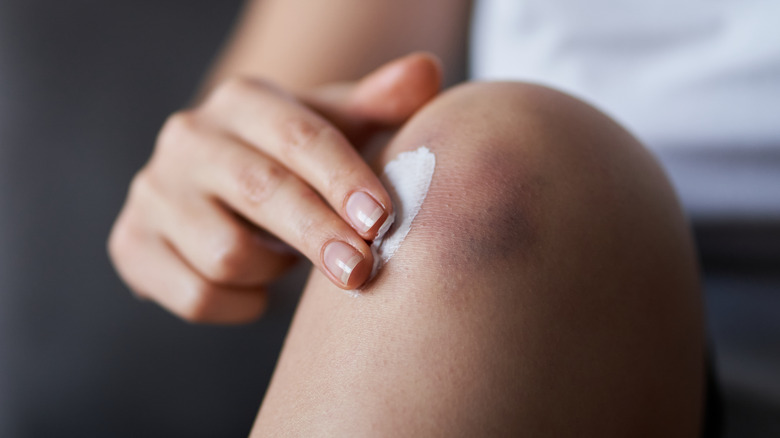What Is The Wear-And-Tear Theory Of Aging?
Sometime around the age of 30, your body begins to lose bone mass. Granted, if you do weight-bearing exercise, you'll still be able to add bone mass to your body. Eventually, you'll reach an age when your bone-building ability can't keep up with the bone deterioration, according to the National Institute on Aging. Why, how, and when our bodies begin to decline is what is included in biological theories of aging (via Physiopedia).
According to a 2013 article in the Korean Journal of Audiology, there are two main perspectives on aging. The first perspective on aging is that humans are genetically programmed to age. For example, genetic program theory says that each species has a specified average lifespan. Although the average lifespan of humans has slowly increased, the maximum age that a single human can live hasn't changed much. These theories suggest that no matter what we do to maintain a healthy body, we can't stop the aging process (via Healthline).
The second perspective on aging is that there are harmful factors that contribute to our aging. This class of aging theories is known as damage or error theories, and the wear-and-tear theory of aging is considered to be a damage theory (via a 2010 article in Aging and Disease).
The basic principle of wear-and-tear theory
August Weismann conceived the wear-and-tear theory of aging in 1882 (via LibreTexts). Like a machine, the body wears out with use (via a 2015 article in Disease-a-Month). Various parts of the body such as our cells and tissues break down over time. Wear-and-tear theory relies on the concept of entropy, which is the principle that all matter reverts back to its random state (via Programmed Aging Theory Info).
Included with wear-and-tear theory (and other damage theories) is that obesity, food, alcohol, and lifestyle also contribute to aging (via a 2013 article in the Korean Journal of Audiology). Free radicals and oxidative stress damage the body, and this damage leads to disease (via a 2015 article in Antioxidants). As this damage increases, the repair functions begin to slow down.
A 2004 review in Rejuvenation Research suggests that the wear and tear that can lead to osteoarthritis puts the joints in the stage where they are no longer able to repair themselves.
Criticisms of the wear-and-tear theory
According to Programmed Aging Theory Info, wear-and-tear theory doesn't consider how the body repairs itself and continues to grow. Even if we break a fingernail, it eventually grows back. Nature uses energy to maintain organisms. Wear-and-tear theory also doesn't consider that some living organisms don't age, and others die not from aging but during reproduction. Because the aging process is more complex than wear and tear, modern biology doesn't follow this simplistic approach to aging.
A 2010 article in Rejuvenation Research said that because our bodies are capable of repairing and restoring themselves, we should be looking more toward what holds back this process. In other words, aging is about looking at what the point is when damage is faster than regeneration.
A 2015 article in Antioxidants suggests that there is more to aging than wear and tear. Instead, it says that many factors interact with one another to progress or slow aging. Therefore, it might help to look at what factors slow and progress the aging process.
Factors that slow aging
According to Healthline, better nutrition and hygiene, improved access to health care, and medical breakthroughs have increased life expectancy around the world. One way to improve your health is through your diet. Eating fruits, vegetables, whole grains, and lean protein will slow some natural aging. Try to eat food that is natural, rather than processed, according to WebMD.
Blood pressure and cholesterol rise as muscle mass and our nervous system decline with age, according to Harvard Health Publishing. Endurance exercise can protect your body from some of the metabolic effects of age by reducing body fat, lowering blood glucose, and reducing cholesterol. Weight training improves muscle mass and bone strength, and flexibility and balance training help prevent injuries.
According to National Institute on Aging, you can slow aging and improve your cognitive health by reading books, taking classes, or learning a new hobby. Because chronic stress can affect your brain, find ways to reduce your stress such as journal writing, breath practices, or mindfulness meditation.
Factors that accelerate aging
WebMD says cigarette smoking leads to heart disease and lung disorders. Smoking also can make you biologically age one and a half times faster than non-smokers, according to a 2018 study in the European Respiratory Journal. Smoking also makes your skin age faster, which means more wrinkles (via Mayo Clinic).
A beer or a glass of wine after a hard day of work might be a nightly habit, but drinking more than that over time can lead to health problems such as cancer, liver damage, and immune system disorders, according to the National Institute on Aging. Alcohol can also make certain health conditions worse such as high blood pressure, osteoporosis, and mood disorders.
If you're sleep-deprived now, you might find your body will age faster, according to the American Academy of Sleep Medicine. Missing your required seven hours of sleep a night can age cells, which can lead to conditions such as multiple sclerosis, heart disease, and cancer.
Mindset sometimes matters
The wear-and-tear theory of aging might focus on biological aging, but what about psychological aging? Harvard University's Ellen Langer conducted a landmark study in the 1970s where she had a group of men live in an environment with historical cues similar to 22 years earlier. By living in an environment that reminded them of their youth, the men's sight improved and they sat taller. One man who needed a wheelchair walked out with a cane (via The New York Times Magazine).
According to Baystate Health, your attitude toward aging can influence your health. In other words, if you believe that old people can't move or think, you could create this reality within yourself. Instead, you can change your stereotype of what an old person can do and find inspirational role models of aging. Having religious or spiritual beliefs can also create a positive mindset, which can increase longevity. Spending more time with positive people and nurturing good relationships can also improve your psychological health.






